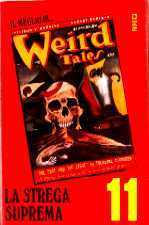
Part of Series
-L'ultimo orrore (Antologia) Traduzione di varî pag. 5L'ultimo orrore (Racconto lungo, The Last Horror, 1927) di Eli Colter Traduzione di Maria Grazia Fiore e Gianni Pilo pag. 51La stirpe di Bubastis (Racconto, The Brood of Bubastis, 1937) di Robert Bloch Traduzione di [Gianluigi Zuddas] pag. 75Detriti dal cielo (Racconto, Skydrift, 1949) di Emil Petaja Traduzione di Maria Grazia Fiore e Gianni Pilo pag. 97L'immortale (Racconto, The Undead Die, 1948) di E. Everett Evans Traduzione di [Gianluigi Zuddas] pag. 123Caronte (Racconto, Charon, 1935) di Laurence J. Cahill Traduzione di Maria Grazia Fiore e Gianni Pilo [?] pag. 149L'isola degli obbrobri (Racconto lungo, The Isle of Abominations, 1938) di Kadra Maysi Traduzione di Maria Grazia Fiore e Gianni Pilo pag. 191INDICE
Authors

Emil Petaja (1915 - 2000) was an American science fiction and fantasy writer whose career spanned seven decades. He was the author of 13 published novels, nearly 150 short stories, numerous poems, and a handful of books and articles on various subjects. Though he wrote science fiction, fantasy, horror, detective fiction, and poetry, Petaja considered his work part of an older tradition of "weird fiction." Petaja was also a small press publisher. In 1995, he was named the first ever Author Emeritus by the Science Fiction Writers of America. Of Finnish descent, Petaja's best known works are comprised of a series of science fiction novels based on the Kalevala, the Finnish verse epic. Petaja's series brought him readers from around the world,[1] while his mythological approach to science fiction was discussed in scholarly publications.[2] In a statement published in Contemporary Authors (Gale Research, 1984), Petaja commented, "My writing endeavors have mainly been to entertain, except for the factual material concerning Hannes Bok and fantasy art in general, which serves to indicate my enthusiasm for these subjects. My novels about the Finnish legendary epic Kalevala: The Land of Heroes spring from a lifelong interest in this fine poetic work. I own six translations of the Kalevala, as well as the work in the original. Both of my parents were Finnish."[3]
Pseudonym of May Eliza Frost Aka May Eliza Harvey, Eliza Mae Harvey. May Eliza Frost went by the name Eli Colter, in print and in her private life. She adopted that name in the early 1920s and used it as her byline in hundreds of stories, serials, and novels, mostly Westerns, but also including what she called "problem life stories" and weird fiction. She was born on September 30, 1890, in Portland, Oregon, where she spent most of the first half of her life. She attended the Ladd School in her native city, but when she was thirteen, blindness struck. She regained her sight and—determined to become a writer—began a course of self-education. May Eliza played piano and pipe organ in movie houses to make her living. In 1922 she submitted a story to Black Mask Magazine. It was her first submission and her first published story. Over the next thirty years, the name Eli Colter became a fixture on the covers of pulp magazines and popular novels. Eli Colter wrote a dozen stories and serials for Weird Tales, beginning with "Farthingale's Poppy" in July 1925. The fourth part of her serial "On the Dead Man's Chest" was voted second most popular of all stories printed in Weird Tales in April 1926. She was in good company, for H.P. Lovecraft came in first with "The Outsider," while Robert E. Howard's "Wolfshead" received third place. Eli Colter topped her previous mark with the most popular stories in January 1927 ("The Last Horror"), August 1927 (part three of the serial "The Dark Chrysalis"), and August 1928 ("The Man in the Green Coat"). "The Last Horror" fell into seventh place among all-time most popular stories behind works by A. Merritt, C.L. Moore, H.P. Lovecraft, Seabury Quinn, Nictzin Dyalhis, and Edmond Hamilton. It was also reprinted in the February 1939 issue and was voted fourth most popular story by readers of Weird Tales for that issue. Despite her popularity, Eli Colter never earned a spot as the author of a cover story for Weird Tales.


